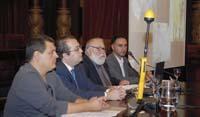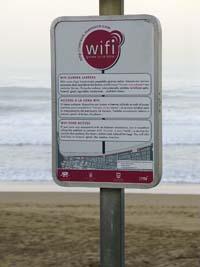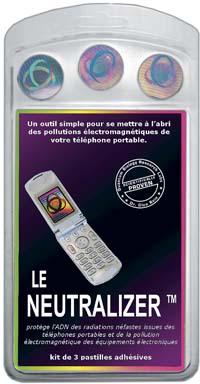Fears in the air

The consequences for the health of wireless communication technologies concern
At the beginning of this course, taking into account the health of children, a platform requested the withdrawal of WiFi or the wireless Internet network in schools. The platform is formed by groups of antennas from different villages, associations of neighbors of Bilbao, two ecological groups and the association of affected by the electromagnetic fields ACACEM, which are based on the precautionary principle in the application.
In addition to WiFi, antennas that provide coverage to mobile phones also concern these groups and other citizens. In some cases, the concern has also reached the courts, for example, in 2001 the Office 2 of Instance Nº 1 of Bilbao ordered the withdrawal of an antenna for possible damage to a seven-year-old girl with hyperactivity syndrome.
These examples show that, in what is said to be a communication society, there are people concerned - and scared - about some technologies that facilitate communication. In particular, it concerns the effects on the health of electromagnetic waves emitted by mobile phones and their antennas, so that more and more people and associations are demanding not to put antennas in their home environment.
However, mobile antennas have increased considerably in recent years, for example, according to the Spanish Ministry of Industry, in San Sebastián there were 106 antennas in 2007, compared to 271 in the previous year. The WiFi has extended a lot, not only in the homes, but also in the public places, as is the case of Bilbao, where the City Council has enabled the possibility of accessing the Internet through WiFi in all the neighborhoods, specifically in 39 points.
Curiosity and flavors

We are currently working on the preparation of an ordinance regulating the location and placement of mobile antennas in Donostia. With the aim of informing citizens and resolving their doubts, the City Council organized two talks in collaboration with the Cristina Enea Foundation. The first referred to the health condition of electromagnetic pollution (sic) and the second to legislation.
The number of attendees to the first conference was a reflection of the interest raised by the theme, since the plenary hall of the city hall was filled. According to comments that people made before the conference began, above all they went to listen to one of the speakers, Dr. Bardasano.
José Luis Bardasano is a professor at the University of Alcalá de Henares and president of the European Federation of Bioelectromagnetism and Health Sciences. As can be seen on the website of this European federation, it consists of three associations, the three Spanish, and none of them very well known or prestigious.
For, according to Bardasano, electromagnetic waves have a great influence on the organism, since "we are rhythmic and synchronize with the cosmic rhythms that surround us. If these rhythms are broken, there can be damage." It says that the night lights cause the rhythms to break and that the same happens with the waves we do not see, as the ones emitted by mobile phones and mobile phone antennas.
In his intervention in San Sebastian, he cited a series of studies that show that mobile phones are harmful to health, including that of the team of neurologist Salford of the Lund University of Sweden: "Nerve Cell Damage in Mammalian Brain after Exposure to Microwaves from GSM Mobile Phones" (Environmental Health Perspective 2003). The researchers found that after two hours of mobile exposure, rats suffered damage to the bark, hypothalamus, and other brain structures.

In Bardasano's view, "it is clear that electromagnetic fields, including mobile telephony, destroy the cells of the hypothalamus and the pineal gland." However, hundreds of research carried out in different laboratories around the world have found no evidence of this, and the World Health Organization and the Science Committee of the European Union have concluded the same by reviewing these research. The rest of the research mentioned by Bardasano is not found in conventional scientific journals.
After Bardasano, Juan Antonio Romo, of the Department of Electronics and Telecommunications of the UPV, spoke about the legislation that regulates the implementation of mobile phone antennas mostly, and the final speaker was Pedro Belmonte, of Ecologists in action.
Belmonte reported that the Spanish Ministry of Industry does not know the number of mobile base stations, some 60,000 according to Ecologistas in action. In addition, he noted that in other places the regulations are stricter than in Spain. All this generates doubts for what requested clear information to the institutions.
Measure of concern
The session ended with people's questions and, then, it became clear again that it was mostly to listen to Bardasano, for whom most of the questions were. He had no time to respond to everyone, but he explained, for example, the neutralizer that works best, because more than one listener had that concern.

The neutralizers are stickers that stick on the mobile phone. If in the Google Internet search engine we write the words neutralizer and mobile phone in Spanish or English, thousands of entries appear. There are many forms and prices, and in explaining how many phenomena work, each one of them his and, in most cases, the most curious and cryptic. More than one says it is the only one that has proven effectiveness.
At the San Sebastian conference, Bardasano was asked by the best, German or Russian neutralizers. He opted for the Russians and, at the same time as he showed his sticker on his mobile, said they used "outdated technology", but among those who have tried the best are them. Yes, he did not explain how they work because no one asked him about it. Apparently, listeners did not doubt that they worked.
A week later, the second conference, a monograph on legislation, was not as successful in number of attendees as in health. Evidently, people are more concerned about health than about laws and regulations.
However, a Eurobarometer survey reveals that when asked about the factors that may pose a risk to health, mobile phones and antennas do not appear among the first.
The survey was published in June 2007. They did so to know the opinion of the Europeans on electromagnetic fields, in particular, if they considered them dangerous to health. Thus, in the first question, from a list of 15 factors, each of them had to answer about the impact that he thought had on health, either to a large extent, or at all.

For those who responded, chemicals are the most dangerous for health (64% believe they have a strong influence on health). It is followed by food (59%), air quality and water (51% and 50%), and below are other items such as landfill, sun, noise... Mobile phone antennas (36% very dangerous), mobile (28%) and computers (18%) appear in the last five places on the list.
As for concern about the health effects of electromagnetic fields, half responded affirmatively and the other half stated no.





